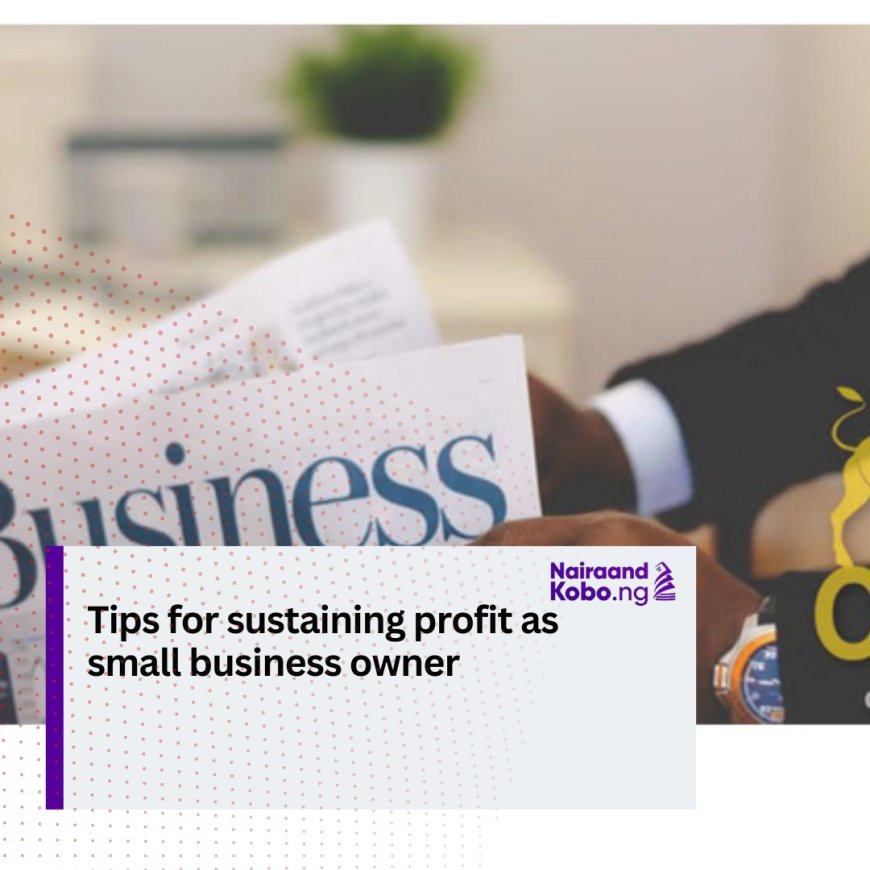Tips for sustaining profit as small business owner

In this article, PRINCESS ETUK suggests ways to effectively manage profitability to ensure long-term success as a small business owner
Profit is one of the best metrics for measuring a business’s success. Simply put, it is the amount remaining after deducting total expenses from total revenue. This remaining amount, the profit, can either be retained in the business for reinvestment to support future growth or distributed as dividends or draws to stakeholders.
Profit is often called the bottom line. This term comes from its position at the bottom of the income statement in financial accounts, where it is also known as net income. If you are increasing your revenue through more sales or decreasing your costs by operating efficiently, you are said to be improving your bottom line.
Here are some of the things that will help your business be profitable:
Understand your break-even point
To determine if your business can make a profit, you first need to know your break-even point. Many startups do not achieve profits immediately; the initial stages often involve investing and incurring some losses before breaking even.
The BEP is the point at which your revenue equals your expenses, resulting in neither profit nor loss. Knowing your BEP informs you of the quantity of products or services you need to sell to move beyond this point and achieve profitability.
You can also use the BEP to decide whether you need to increase prices, reduce costs, or both to achieve future profits.
How to improve profits
Generally, higher profits indicate a healthier business and may lead to an increase in your business’ value. Once you achieve profitability, you can choose to either reinvest the money to fund expansion and future growth or distribute it to yourself and other shareholders.
When considering how to increase profits, it is crucial to be aware of potential long-term negative consequences of short-term strategies. Business is fundamentally about building and maintaining relationships to create valuable and useful products or services that generate sales. Focusing solely on increasing profits could harm these relationships and, consequently, your future profitability.
Carefully consider the following strategies and proceed with caution:
Implement a budget
Creating a business budget is essential to identifying which strategies will most effectively boost your profits. While you may aim to increase sales, you need to consider if your employees can handle the additional workload. How much extra production will be required? What additional marketing efforts will be necessary to achieve those sales? A business budget will provide reliable insights to answer these questions.
Know your profit margins
Understanding your profit margins is a crucial part of your business budget. These margins indicate your business’s profitability by showing if your current pricing covers your direct expenses and generates profit. Commonly used margins include gross profit margin and net profit margin. If your profit margins are shrinking, you’ll need to reassess your pricing, sales, costs, or a combination of these factors. Benchmarking these margins against industry standards can also help gauge your business’s performance relative to competitors.
Increase your prices
While many business owners instinctively reduce prices to stay competitive, this can negatively impact profits. Instead, consider raising the prices of your products or services. A slight price increase can significantly boost your profits, as you will earn more per sale with less additional effort. However, you must carefully balance this decision, as excessive price hikes could drive customers to competitors, potentially reducing sales.
Expand your customer base
Increasing your number of sales can lead to higher profits. Building a loyal customer base that makes repeat purchases is vital for growth. Strategically explore new target markets and assess how your current products or services fit those markets. Adjustments may be necessary to meet the needs of new customers. While acquiring new customers requires time, effort, and resources, an alternative strategy is to encourage existing customers to purchase more from your business, as they are already familiar with and trust your brand.
An economist, Professor Sheriffdeen Tella, stressed the importance of expanding market reach and increasing output as key strategies for reducing unit costs and boosting profits.
“Engaging in the personal distribution of goods produced, expanding the market to increase outputs. The bigger the output, the lower the unit costs,” he explained.
He further recommended seeking financial resources to support production expansion, which he believes will contribute to increased profits.
Eliminate unprofitable products
Identify which products or services are profitable and which are not. Discontinuing unprofitable offerings can reduce costs and ultimately improve your bottom line.
Manage costs
Evaluate the efficiency of your back-office systems in tracking costs, such as rent, utilities, materials, marketing, and employee expenses. Understanding how rising costs affect your profit margins is essential. If costs are increasing, review your supplier relationships and seek ways to achieve efficiencies and enhance profits.
Tella highlighted the significance of cutting production costs by exploring alternative, cost-effective methods.
He advised, “To increase profitability, you will need to cut down on the cost of production by looking at alternative methods and choosing the least cost.”
Improve productivity
Assess if your employees can increase their output within the available time. Explore ways to enhance efficiency and effectiveness through better systems and processes. If your business produces goods, evaluate how much is being wasted or damaged during production. Reducing waste can boost sales and profits.
Resource management
Consider workflow management, cash flow, supplier relationships, staff training, and maintaining high-quality services or products. A solid strategy from the beginning positions you better to manage the bigger picture, measure your business against competitors, and prepare for various scenarios.
Be self-motivated
Initial excitement can wane as the daily grind sets in. Keeping your passion alive is crucial for motivating your staff and inspiring your customers. Find ways to maintain that spark despite the endless to-do list.
Also, circumstances can change dramatically, necessitating a pivot in your business model. Whether it is offering a new product or service, operating differently, or entering a new industry, staying flexible and ready for change is key.
Make your customers loyal
Loyal customers are valuable, but relying too much on them can be risky if they suddenly leave. Continuously innovate and diversify to attract new clients and offer new products or services, even with limited resources and staff.
When expenses rise and income drops, your business is in trouble. Costs for raw materials, labour, shipping, and utilities can vary, and smaller businesses might have to work with more expensive suppliers. Stay realistic about what you can afford and negotiate the best rates possible to protect your profit margins.
Proper accounting
Many new business owners lack accounting or bookkeeping expertise, making financial management time-consuming and stressful. Keeping track of paperwork, especially for taxes, can distract from other crucial activities like expanding product listings, focusing on higher-value offerings, and improving customer relationships.
Increase order values
Growing profits by maximising the value of existing customers is easier and less costly than recruiting new ones. Review your products and services for opportunities to bundle related add-ons as cross-sells or up-sells. Consider increasing the purchase size of your offerings, such as expanding from five to ten products per pack or from five to ten hours in a professional services package.
Work on branding
Enhancing your company’s image can help reposition your brand from a mid-tier offering to a premium one, allowing you to command higher market prices. Simple changes like tweaking colors and logos, or emphasising value-added services, exceptional customer service, and a strong reputation can make a difference.
Additionally, by highlighting how your product or service can improve people’s lives, you can forge an emotional connection with customers, creating a sense of necessity and aligning your brand with a desirable lifestyle.
Cut non-profitable offerings
Evaluate the profitability of all your products and services to identify those that are time-consuming but unprofitable. It’s essential to understand your customers to avoid losing a significant group who appreciate the convenience of a comprehensive selection. If there are no major downsides, removing these unprofitable offerings can quickly enhance your bottom line.
Optimising inventory management
Recently, many companies have been forced to carry more inventory than desired, but storing excess or slow-moving stock ties up cash and incurs significant expenses. While reducing inventory without investing in management software is challenging due to supply chain uncertainties, there are usually various methods to cut inventory costs, though their effectiveness varies by business. Currently, the best approach is to eliminate obsolete stock and focus on the ability to adapt to changing consumer needs.
Empower employees
Empowering, appreciating, and investing in employees not only boosts their productivity but also turns them into strong advocates for your business. Rewarding performance fosters a culture of achievement, and offering sincere praise helps create a positive work environment.
Expand to new markets
Research the local market to determine if you have maximised its potential. It might be time to explore new geographies, whether nationally or internationally, or to expand your digital presence by offering products and services online.
Refreshing an existing product can also prevent profit stagnation. Regularly seek customer feedback to identify gaps in your offerings. Consider how you can meet new needs with your existing resources and focus on those that will have the most significant impact on your bottom line.
According to an economist, Austin Iraoya, understanding the market is crucial for effective cost management.
He stated, “From my economic perspective, there are things that contribute to the economic perspective of a small or medium-sized entrepreneur. Number one has to do with the business person having a good understanding of the market. When you have a good understanding of the market, it informs how you go about getting your goods and that will go a long way in influencing your cost of running a business.”
Develop a good marketing strategy
Iraoya also emphasised the importance of a solid marketing strategy in today’s business environment.
“To have that in place, you need to have a good marketing strategy. Good marketing strategy in these times goes beyond having a sales point. Sales points could be physical and virtual, particularly making use of the various digital platforms that we have, including social media handles. That will go a long way in improving profitability,” he noted.
Produce quality
Furthermore, Iraoya underscored the necessity of maintaining high-quality standards in products and services.
He warned that the initial profit from a sale could be short-lived if the product quality fails to meet customer expectations.
“If I patronise an entrepreneur today, no matter the price, the first thing I would watch out for is the quality. The price may be competitive, but if the quality is not good, there is no motivation to patronize such an entrepreneur any more,” Iraoya said.
He concluded that sustained profitability hinges on delivering top-notch quality, adding, “For sustained profit, the quality of service that the entrepreneur is offering must be top-notch.”



 moderator
moderator 





